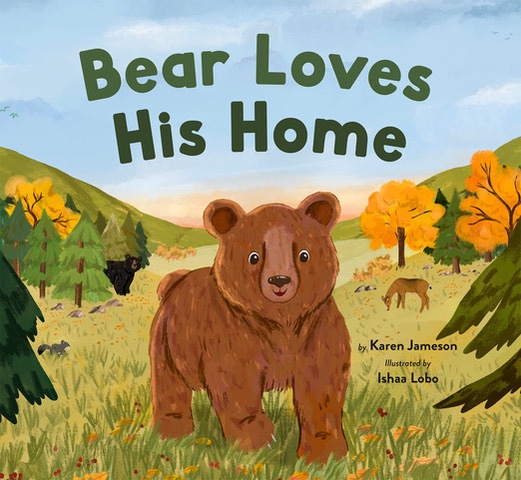I can “bearly” contain my excitement at the upcoming release of BEAR LOVES HIS HOME, written by yours truly and beautifully illustrated by Ishaa Lobo. Published by the esteemed Yosemite Conservancy, our cub makes his debut on August 26, 2025. This lyrical nonfiction picture book comes from the heart, combining my lifelong passion for national parks, wildlife and bears. So, why bears?
As a child growing up in the suburbs, my bear obsession was largely shaped by Saturday morning cartoons and anthropomorphic characters from literature. Yogi Bear and Boo Boo, Paddington, Corduroy, Goldilocks and the Three Bears and Winnie the Pooh all played into my “understanding” of bears and their traits. So, how do these impressions stack up to the truth? Let’s play true or false (T or F) and see if you can tell fact from fiction about North American black bears.
#1 Bears love picnic baskets! T or F?
Yogi and Boo Boo were always after these baskets of deliciousness at Jellystone Park! Do real bears love them, too? Real bears do not talk or wear hats and ties like these charming characters. But, if like Yogi and Boo Boo, they are conditioned to be around people, they may grow bold and help themselves to your picnic basket.
We want them to eat their natural bear foods, which is best for our safety and theirs. So, don’t feed the bears! Always secure food, pet food, trash, and even toothpaste in a bear storage locker to keep bears and other wild animals out of your campground.
#2 Bear families- mama, papa and cub(s) – live together. T or F?
Goldilocks stumbles upon a bear family’s house in the woods and makes herself at home. Real bears do not sit in chairs, sleep in human beds, make porridge or live in houses. And bear parents and their cubs do not all live together.
In bear families, the mama is a single parent! She feeds and nurtures the cubs, protects them and teaches them to forage for food, climb trees, and do all the things they need to learn to survive. She hibernates with them during winters and makes a new sleeping spot every night during the warmer months. Papa bears go off on their own after mating, leaving mama to do it all.
#3 Bears will do their best to avoid bees. T or F?
Winnie the Pooh is always trying to outsmart bees to get to their honey! Do real bears strategize to avoid bees or simply go on instinct? Here’s the buzz. While we can’t know for sure what bears are thinking, we do know this:
Real bears do not talk or float up (on balloons) to reach bee hives in trees or hide out in mud puddles under the protection of an umbrella. However, when they hear the hum of the bees and smell the honey, they appear fearless in their pursuit of this sweet treat. Not even the risk of stings will keep them from going after a hive.
#4 Black bears live in England. T or F?
Paddington is a British bear who loves tea, marmalade and all things related to London society. Originally from Peru, he is known to go exploring in the UK proper.
Real North American black bears live in – you guessed it – North America! They populate hardwood forests, forest clearings, swamps and mountains in the United States, Canada and Mexico. Paddington is modeled after the Andean bear, otherwise known as the spectacled bear. There are no longer any endemic bears living in England. Fun fact: The real-life Winnie the Pooh – a North American black bear – lived in The London Zoo after serving as a mascot to Canadian troops during WWI.
#5 Black bears have nighttime adventures. T or F?
Corduroy, a department store bear who is dreaming of finding a button for his overalls (and a friend), goes on a nighttime adventure in the store after hours. But, do real bears venture out at night?
North American black bears are typically crepuscular animals, mostly active during dawn and dusk, though not exclusively. Just like our main characters in BEAR LOVES HIS HOME, they venture out at these times to feed.
Answers: 1- T 2- F 3- F 4- F 5-T
You can see that our fictional bear characters have mostly led us astray! Ha! BEAR LOVES HIS HOME is a chance for kids to pick up a lot of bear facts while following adorable Bear (and mama) on their autumn forage.
As for my love of national parks, I urge you to seize the moment and support the protection of these natural lands, which are under the threat of development. North American black bears depend upon it, as do countless other species, humans included.
A former teacher, Karen Jameson holds a master’s degree in education. She has found the perfect way to combine her love for language, learning, poetry, and animals in her prolific picture book career. Karen is the author of WOODLAND DREAMS, FARM LULLABY, WHERE THE WEE ONES GO, and the forthcoming WAKE UP WOODLANDS (Chronicle), TIME TO SHINE (Groundwood), and A LLAMA IS NOT AN ALPACA (Running Press Kids) and many more.
